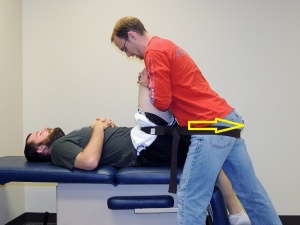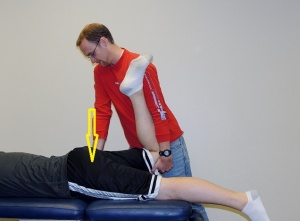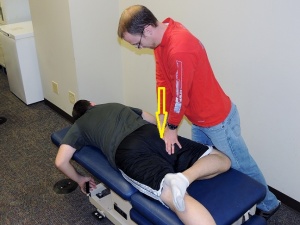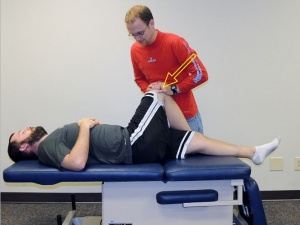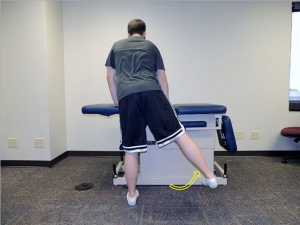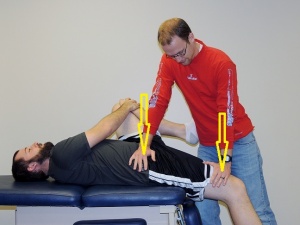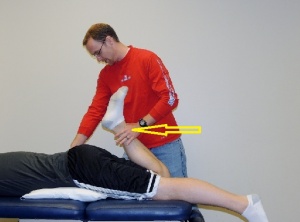Regional Interdependence in Low Back Pain: Interventions
Original Editors - Brandan Lym, Mitchell Blythe, Cory Horstman, Nathan Domino, and Dana Schmidt part of the Des Moines University Student Project
Regional Interdependence[edit | edit source]
- Regional interdependence is the concept that a musculoskeletal treatment targeting a specific area of the body could have effects in another, seemingly unrelated, part of the body[1].
- Examples of Regional Interdependence:
- Elbow
- Shoulder
Lumbar Examination[edit | edit source]
Screen patient for red flags[2]
| Condition | Red Flags |
| Back-related tumor |
|
| Cauda equina syndrome |
|
| Back-related infection |
|
| Spinal compression fracture |
|
| Abdominal aneurysm |
|
Physical Impairment Measures[2]
- Evaluate Thoraco-Lumbar Active and Passive ROM
- Segmental Mobility
- Pain Provocation with Segmental Mobility Testing
- Judgments of Centralization during Movement Testing
- Look for a centralization of pain with repeated motion in a specific direction.
- Prone Instability Test
- Judgments of the presence of aberrant movement
- Straight Leg Raise
- Slump Test
- Trunk Muscle Power and Endurance
- Passive Hip Internal Rotation, External Rotation, Flexion, and Extension
- Mental Impairment Measures
- Fear Avoidance Beliefs Questionnaire
Also consider Hip Examination
- Active and Passive ROM
- Joint Mobility
- Strength
Interventions[edit | edit source]
In the articles reviewed, the following interventions were found to be beneficial in the treatment of low back pain.
Thoracic Spine[3][edit | edit source]
Manipulation
- Supine Thoracic Posterior to Anterior HVLA Manipulation
Hip[4][5][6][7][8][edit | edit source]
Manipulation
- Supine Long Axis Distraction HVLA Manipulation
Mobilizations
- Supine Hip Caudal Glide Mobilization
- Prone Hip Posterior to Anterior Mobilization
- Hip Posterior to Anterior Mobilization with Flexion, Abduction, and External Rotation
- Hip Anterior to Posterior Mobilization with Flexion, Adduction, and Internal Rotation
- Hip Mobilization Physiopedia Page
Therapeutic Exercise
- Strengthening
- Hip Abduction with slight extension and internal rotation
- Flexibility
- Supine Iliopsoas Stretch
- Prone Rectus Femoris Stretch
Outcomes[edit | edit source]
| Articles | Level of Evidence | Improved Oswestry Disability Index Score | Improved Fear Avoidance Behavioral Questionairre Score | Improved Global Rating of Change Score | Improved Modified Spinal Stenosis Scale Score | Improved Pain Pressure Threshold | Decreased Pain | Improved Function | |
| Burns et al. | 4 | X | X | X | X | ||||
| Cibulka | 4 | X | X | X | |||||
| Oliviera et al. | 2 | X | X | ||||||
| Whitman et al. 2003 | 4 | X | X | X | X | ||||
| Whitman et al. 2006 | 2 | X | X | X | X | X | |||
| Lejkowski & Poulsen | 4 | X | X |
Clinical Implications
[edit | edit source]
- Utilizing manual therapy interventions targeted at the hip and thoracic spine along with therapeutic exercise has been shown to provide improved outcomes for patients with low back pain. Clinicians should consider these interventions along with treatments focused on the low back to treat the entire patient and achieve improved results. Additional information can be found in the references listed below.
References[edit | edit source]
- ↑ Wainner RS, Whitman JM, Cleland JA, Flynn TW. Regional Interdependence: A Musculoskeletal Examination Model Whose Time Has Come. J Orthop Sports Phys Ther 2007;37(11):658-660. Pub Med Link: http://www.ncbi.nlm.nih.gov/pubmed/18057674 (accessed 26 Oct 2013).
- ↑ 2.0 2.1 Delitto A, George S.Z. et al. Low Back Pain Clinical Practice Guidelines Linked to the International Classification of Functioning, Disability, and Health from the Orthopaedic Section of the American Physical Therapy Association. J Orhtop Sports Phys Ther. 2012;42(4):A1-A57 Pub Med Link: http://www.ncbi.nlm.nih.gov/pubmed/22466247 (accessed 26 October 2013).
- ↑ Oliveira RF, Liebano RE, Costa LCM, Rissato LL, Costa LOP. Immediate Effects of Region-Specific and Non-Region-Specific Spinal Manipulative Therapy in Patients With Chronic Low Back Pain: A Randomized Controlled Trial. Phys Ther 2013;93(6):748-756. Pub Med Link: http://www.ncbi.nlm.nih.gov/pubmed/23431209 (accessed 28 Oct 2013).
- ↑ Whitman JM, Flynn TW, Fritz, JM. Nonsurgical management of patients with lumbar spinal stenosis: a literature review and a case series of three patients managed with physical therapy. Phys Med Rehabil Clin N Am 2003;14:77-101. Pub Med Link: http://www.ncbi.nlm.nih.gov/pubmed/12622484 (accessed 29 Oct 2013).
- ↑ Whitman JM, Flynn TW, Childs JD, et al. A comparison between two physical therapy treatment programs for patients with lumbar spinal stenosis: a randomized clinical trial. Spine 2006;31(22):2541-2549. Pub Med Link: http://www.ncbi.nlm.nih.gov/pubmed/17047542 (accessed 29 Oct 2013).
- ↑ Cibulka MT. Low Back Pain and its Relation to the Hip and Foot. J Orthop Sports Phys Ther 1999;29(10):595-601. Pub Med Link: http://www.ncbi.nlm.nih.gov/pubmed/10560068 (accessed 26 Oct 2013)
- ↑ Lejkowski PM, Poulsen E. Elimination of intermittent chronic low back pain in a recreational golfer following improvement of hip range of motion impairments. Journal of Bodywork & Movement Therapies 2013;17:448-452. Pub Med Link: http://www.ncbi.nlm.nih.gov/pubmed/24139002 (accessed 29 Oct 2013).
- ↑ Burns SA, Mintken PE, Austin GP, Cleland J. Short-term response of hip mobilizations and exercise in individuals with chronic low back pain: a case series. Journal of Manual and Manipulative Therapy 2011;19(2):100-107. Pub Med Link: http://www.ncbi.nlm.nih.gov/pmc/articles/PMC3172945/ (accessed 29 Oct 2013).
